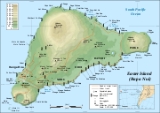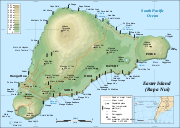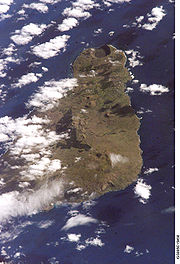
Terevaka
Encyclopedia
Ma′unga Terevaka is the largest, tallest (507.41 m (1,664.73 ft)) and youngest of three main extinct volcanoes that form Rapa Nui (Easter Island
) (a Chile
an island in the Pacific Ocean
). Several smaller volcanic cones and craters dot its slopes, including a crater hosting one of the island's three lakes, Rano Aroi.

 While Terevaka forms the bulk of Easter Island, the island has two older volcanic peaks; Poike
While Terevaka forms the bulk of Easter Island, the island has two older volcanic peaks; Poike
which forms the eastern headland and Rano Kau
the southern. Terevaka last erupted in the Pleistocene
and is less than 400,000 years old. Its lava field at Roiho has been dated at between 110,000 and 150,000 years old. Terevaka is rather difficult to climb, and is only accessible by foot or horse. It is very windy at the top.
Easter Island
Easter Island is a Polynesian island in the southeastern Pacific Ocean, at the southeasternmost point of the Polynesian triangle. A special territory of Chile that was annexed in 1888, Easter Island is famous for its 887 extant monumental statues, called moai, created by the early Rapanui people...
) (a Chile
Chile
Chile ,officially the Republic of Chile , is a country in South America occupying a long, narrow coastal strip between the Andes mountains to the east and the Pacific Ocean to the west. It borders Peru to the north, Bolivia to the northeast, Argentina to the east, and the Drake Passage in the far...
an island in the Pacific Ocean
Pacific Ocean
The Pacific Ocean is the largest of the Earth's oceanic divisions. It extends from the Arctic in the north to the Southern Ocean in the south, bounded by Asia and Australia in the west, and the Americas in the east.At 165.2 million square kilometres in area, this largest division of the World...
). Several smaller volcanic cones and craters dot its slopes, including a crater hosting one of the island's three lakes, Rano Aroi.


Poike
Poike is one of three main extinct volcanoes that form Rapa Nui . At 370 metres, it is the island's second highest peak after Terevaka.right|275 px|thumb|[[Ahu Tongariki]] with Poike in the background...
which forms the eastern headland and Rano Kau
Rano Kau
Rano Kau is a tall extinct volcano that forms the southwestern headland of Easter Island, a Chilean island in the Pacific Ocean. It was formed of basaltic lava flows in the Pleistocene with its youngest rocks dated at between 150,000 and 210,000 years ago.- The crater :Rano Kau has a crater...
the southern. Terevaka last erupted in the Pleistocene
Pleistocene
The Pleistocene is the epoch from 2,588,000 to 11,700 years BP that spans the world's recent period of repeated glaciations. The name pleistocene is derived from the Greek and ....
and is less than 400,000 years old. Its lava field at Roiho has been dated at between 110,000 and 150,000 years old. Terevaka is rather difficult to climb, and is only accessible by foot or horse. It is very windy at the top.
External links
- Guide to Easter Island from the Easter Island Foundation
- Old photos of Rano Aroi (upper right)

